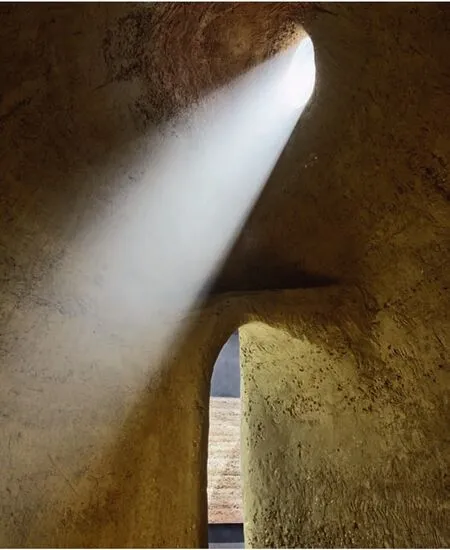泥作,威尼斯,意大利
2017-02-08概念设计安娜赫里格尔马丁劳奇安德烈斯莱皮克
概念设计:安娜·赫里格尔,马丁·劳奇,安德烈斯·莱皮克
泥作,威尼斯,意大利
概念设计:安娜·赫里格尔,马丁·劳奇,安德烈斯·莱皮克

1 泥作装置的外景/Exterior view of the mud installation
受第15届威尼斯国际建筑双年展策展人亚历杭德罗·阿拉维纳的邀请,安娜·赫里格尔、马丁·劳奇和安德烈斯·莱皮克决定将泥土作为展览装置的主题。
全球有30亿人口居住在泥土建造的建筑中。这是有原因的。泥土依然是全球主导性的建筑材料。从拉丁美洲到非洲,从欧洲到亚洲,它几乎在哪里都可以得到,而且造价很低。它直接来源于土地,而且能够不对环境造成任何伤害地回归土地。它从人类聚居的开始就被使用——出于各种各样的目的,无论是在疏朗的乡村还是致密的城市环境中。对于未来,泥土有着难以置信却尚未被挖掘的潜能。
如今,越来越多的泥土构筑物被其他材料取代。那些材料需使用不可再生的资源,耗费大量能源并产生很高的CO2污染。简单地说,这个星球上没有足够的资源来为70亿人口建造混凝土和钢结构的住宅。我们有必要探索泥土,将其作为未来城市和家园的材料。
我们需要做更多的研究、深入地技术研发,开发出新的建筑策略,以应对当下及未来社会的需求和愿景。我们应该不断探讨这种材料,将它广泛在杂志中出版、在展览中展示、并纳入大学教育的课程。我们需要培养新的工匠,我们需要恰当的项目,来展现泥土建筑的稳定性、舒适性、社会和生态作用,以及它的优美。
泥土,远不只是一种建筑材料。人类与这种材料的关联几乎和人类本身一样古老,但我们几乎丧失了与它的联系。这个展览装置就提供了一种非常亲密的材料体验。在这件作品中,最主要的挑战之一就是说服客户相信泥土的品质:它的稳定性,它独特的触觉、丰富的色彩,以及对人类身心的积极影响。这很难用图片来传达,它需要真实可触。□ (黄华青 译)
项目信息/Credits and Data
概念设计/Concept Design: Anna Heringer (Laufen, Germany), Martin Rauch (Schlins, Austria), Andres Lepik (Munich, Germany)
客户/Client: La Biennela di Venezia (Venice, Italy)
策展人/Co-curator: Zsuzsanna Stánitz
场地管理/Site Manager: Stefano Mori, Johannes Lerch
项目经理/Project Manager: Clemens Quirin
结构工程/Structural Engineer: gbd (Dornbirn, Austria)
建筑面积/Floor Area: 70m²
生土/Earth: 110m², 25t
建造周期/Construction Phase: 2016
摄影/Photos: Stefano Mori (fig.1, 5, 7), Bruno Klomfar (fig.2-3), Students of Technical University Munich (fig.4),
线图/Plans: Lehm Ton Erde Baukunst GmbH

2 该泥作被置于夯土地面上且可以进入/The mud "pepita" is placed on a rammed earth floor and can also be entered

3 装置内部的自然采光/Natural lighting inside the "pepita"
Invited by Alejandro Aravena, curator of the 15th International Architecture Exhibition in Venice, Anna Heringer, Martin Rauch and Andres Lepik decided to put mud in the focus of their installation.
3 Billion people on this planet live in buildings made of mud. For good reason.
Mud is still the predominant building material of our world's population. From Latin America to Africa, from Europe to Asia - it is available almost everywhere and at a low cost. It comes directly from the earth and can be returned to the earth without any harm to the environment. It has been used since the beginning of human habitation - for any purpose, whether in spacious rural or dense urban contexts. It has incredible and yet undiscovered potential for the future.
Currently, more and more mud structures are being replaced with materials that require nonrenewable resources that consume energy and create high levels of carbon dioxide pollution. Simply put, the planet does not possess enough resources to build 7 billion homes out of concrete and steel. Society need to explore mud as the material for our future cities and homes.
Architects need more research, detailed technical development, and new design solutions to address the needs and aspirations of current and futures societies. People need to discuss this material more widely publish it in magazines, present it in exhibitions, and users need to embed it in the curriculum of universities. The industry needs to train new craftsmen. Architecture needs projects that reflect the stability, the comfort, the social and ecological relevance, and the beauty of mud design.
Earth is more than a building material. The relationship between human beings and this material is as old as humankind - but society has almost lost contact with it. This installation invites to an experience with this material in a very intimate way. In this installation, one of the primary challenges was to convince clients of the quality of earth: its stability, its haptic treasures, its richness in colors, as well as its positive influence on the body and mind. This is difficult to transmit with pictures. It needs to be touched.□

4 慕尼黑工业大学的学生在夯实夯土地面/Students from Technical University Munich are ramming the rammed earth floor

5 限时的施工现场(施工周期3个月)/Time-lapse of the building site (construction period: 3 months).
评论
穆钧:现代建筑工业高速发展的百年以来,为应对日益多元的建造需求,以钢筋混凝土为代表的现代工业材料及其技术,似乎已表现得无所不能。这使得我们逐渐忘却了,人类基于地方自然材料资源,探索实践数千年形成的丰富多彩的传统营造技术和工艺。客观而言,正如“无所不能”的钢筋混凝土却存在高耗能高污染的缺陷一样,任何材料在不同的层面均存在一定的优点和缺点。但在一味追求“高精尖”的科学态度下,我们的营造传统连同其中蕴含的价值,皆因其存在的所谓缺陷而被忘却甚至被摒弃。安娜·赫里格尔带领设计和实施的“泥作”与“奥米龙休闲空间”,使我们在冰冷的钢筋混凝土丛林中,得以重新触摸和品味人类沉淀千百年的营造传统与智慧,感受那份久违的真实和情感,思考传统的价值之于今天的意义。
张雯:这两个项目中都使用到了生土的另一种建造方式——Zabur技术。与利用模板夯筑的夯土不同,这种建造方式是靠手工塑造成型。土料中含水量较大,搅拌成泥状,便于手工塑形,有时掺杂麦秸等天然纤维。材料和工艺的不同,使得Zabur技术可以建造自由、平滑的曲线造型。奥米龙跨国界项目充分发挥了这一优势,随着土料的竖向堆垛、水平起伏和局部挖孔,实现了墙体、地面、顶棚、家具,乃至灯具设备安装的一体化建造,形成了独特的空间形态,很好地响应了项目的功能需求。在威尼斯双年展的泥作项目中,夯土技术与Zabur技术对比并置,机械夯筑的墙面、地面规整严谨、直来直去,与场地中心手工塑造的空间雕塑的粗粝、曲线、自由的开口进行对比,刻意而充分地展示了两种建造技术的表现性。事实上,生土的建造方式远不止这两种,但都是各自地域性的集中体现。

6 剖面/Section

7 最后一层泥作装置的建造/Building up the final layers of the "pepita"
Comments
MU Jun:One hundred years' rapid development of modern building industry in response to the increasingly diversified construction requirements has culminated in an omnipotence as represented by modern industrial materials and technologies. This may have taken us away from the rich traditional construction technologies and techniques that have developed over millennia's experimentation and practice with local natural material resources. Objectively speaking, as the "omnipotent" reinforced concrete is flawed in its high energy consumption and pollution, any material has certain strengths and flaws in different aspects. However, the blind pursuit of "advanced, accurate, and cutting edge" science and technology has made people forget or even abandon our construction traditions and their inherent values, only because of their so called defects. The "Mud Works" and "Omicron Relaxing Spaces", designed and implemented under the leadership of Anna Heringer, bring us from the cold reinforced forest back to the construction tradition and wisdom that have crystallized over thousands of years. Touching them, savoring them, and we can feel from them a remotely intimate truthfulness and warmness, thus reflecting the significance of traditional values in a contemporary context. (Translated by SHANG Jin)
ZHANG Wen:Both the two projects use another earthen construction technique named "Zabur". Different from rammed earth, Zabur is shaped by hand without shuttering. With more water content, the well-stirred mud is can be easily shaped manually, and sometimes straw and other natural fiber is mixed. Zabur can build free and smooth curve shape depending on different material and techniques. In the project of Omicron Crossing Border & Relaxing Spaces, Zabur produces this advantage to the full. With vertical stacking, the level fluctuation and the local digging holes, the integrated construction of wall, floor, ceiling, furniture, equipment and lamps installation makes a unique form in response to the functional needs of the project perfectly. In Venice Biennale, cob and rammed earth are positioned together, the mechanical rammed walls and ground are straight, regular and rigorous, comparing with the manually created cob space sculpture in the center, which is curve, rough and with free openings. This display deliberately and fully demonstrate the performance of the two kinds of construction technique. In fact, there are more than these two earthen construction techniques which all embodied their region features.
Mud Works, Venice, Italy, 2016
Concept Design: Anna Heringer, Martin Rauch, Andres Lepik
